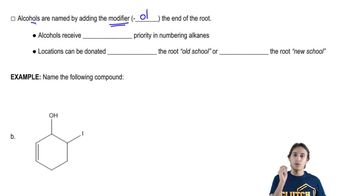Give the products, if any, of each of the following reactions:
c. benzoic acid + CH3CH2Cl + AlCl3
d. benzene + 2 CH3Cl + AlCl3
 Verified step by step guidance
Verified step by step guidance Verified video answer for a similar problem:
Verified video answer for a similar problem:



 4:29m
4:29mMaster Activity and Directing Effects with a bite sized video explanation from Johnny
Start learning